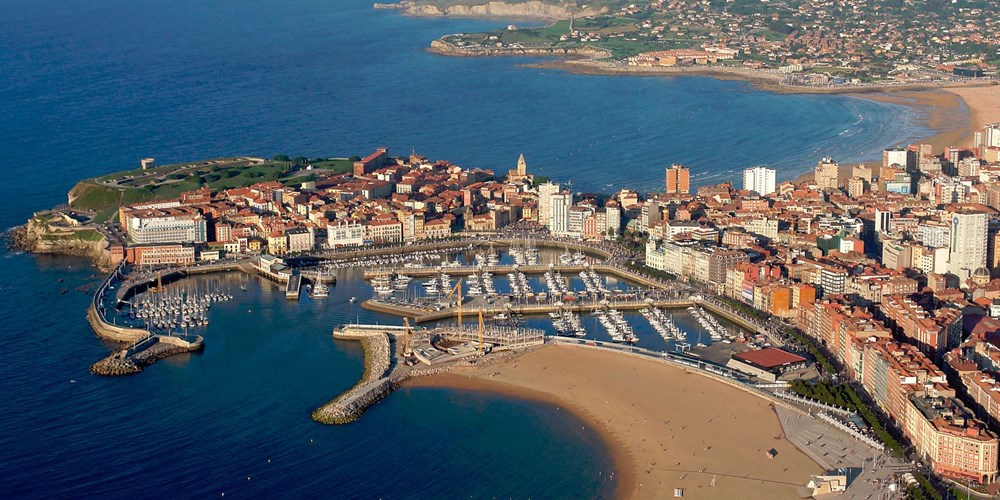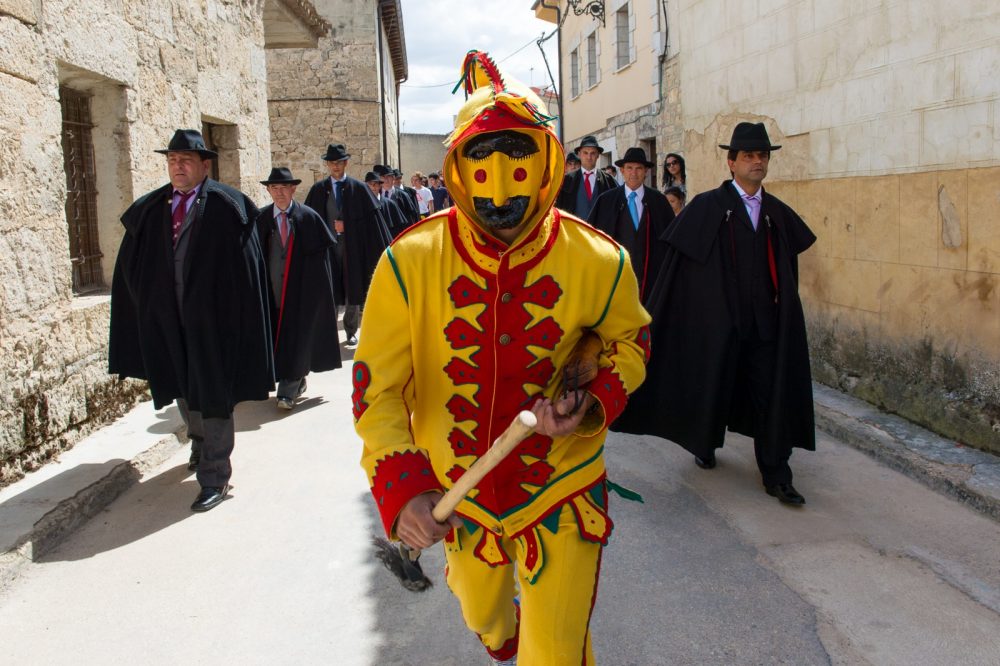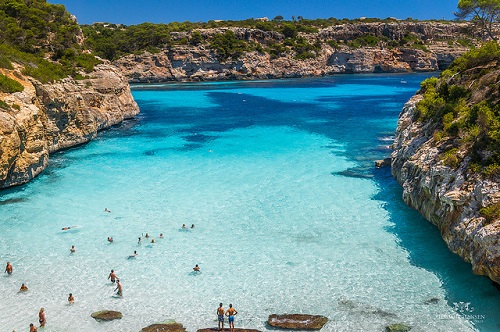Gijón located on the Bay of Biscay, on the Atlantic coast in the northern Spanish region of Asturias. Separated from the rest of Spain by high mountains, this country has an atmosphere and climate very different from what you’ll find in Mediterranean areas. Furthermore, attractions in Gijón will give you a sight about pieces of Roman history, museums, and passing by impressive woodlands until the coast with its large beaches and rocky headlands. In this article, we’ll look at 9 of these top things to discover around the city to make the most out of your vacation here.
1- Laboral Ciudad de la Cultura:
 via – laboralciudaddelacultura
via – laboralciudaddelacultura
This austere gargantuan Franco-era university campus far away from the city about 3 kilometers. That despite being been falling into dilapidation by the 1990s and has become a dynamic art and education center holding part of Oviedo University to conserve the building.
In this university you’ll be able to discover the 1,500-seater theater, visit the attractive major courtyard and wander through the gardens or head up the 130 meters Seville’s Giralda inspired the tower, the tallest building in Asturias with the best views of Gijón from the top and you can also wander through the gardens. This is a great place that will amuse and fascinate many visitors.
2- Jardín Botánico Atlántico:
 via- compartemimoda
via- compartemimoda
Bordering the Laboral Ciudad de la Cultura is the unique botanical garden in Asturias. Opening in 2003 10-hectare of the garden showcasing plants from Spain’s north coast and Atlantic regions. The park divided into four different zones, each one with a distinct environment.
First, there is the Bay of Biscay and the hardwood trees that flourish in this temperate region, like birch, beech, cork, and oak. Second is an orchard area, you will see olive trees, vines that are cultivated on an industrial scale in Spain. The third is the oldest part of the park dates back to the 19th century when the industrialist who owned this land planted camellias, yews, and banana trees. Finally, there’s an Atlantic route, a trail that walks you throughout diverse habitats around this ocean, from the Mediterranean to American boreal, with coniferous forest.
Well, this impressive garden is a wonderful place to have a comfortable walk or a family picnic in a restful atmosphere and provides a lovely break from the chaotic city center.
3- Roman Baths:
 via – turismoasturias
via – turismoasturias
The location of this archaeological site is at a magnificent position, facing the ocean in the Cimadevilla district and next to the Church of San Pedro Apóstol. Besides, this archaeological site dates back around 100 AD is a must-see location for all the history lovers.
Moreover, before you see the remains you’ll get the full lowdown on the role that thermal baths played in Roman society and the difference between the various rooms and how they were heated. You’ll look down at the ruins of the hypocaust, ovens and bathing areas and get 3D reconstructions of how they looked 2,000 years ago.
4- Gijón Aquarium:
 via – atrapalo
via – atrapalo
Gijón Aquarium considered as an amazing sea life center. Besides, holds about 5,000 animals with 400 various marine species that make it the only aquarium in Spain that possess all five kinds of vertebrates such as fish, birds, reptiles, mammals, and amphibians.
More than simply going to see and to get close to animals such as otters, clownfish, sea horses, octopuses, and sharks, you’ll also amuse getting in-depth information about their natural habitats, methods of survival and diet, which is an appreciated educational touch that most of the kids and adults alike because they will admire the touch pools where they can feel the quality of live starfish, as well as pop their head up a viewing glass dome for a diving bell-like surround-view from the base of their aquariums.
5- Cerro de Santa Catalina:
 via – monnuage
via – monnuage
The park Cerro de Santa Catalina is a striking area where you’ll enjoy taking a comfortable walk or having a friend or family picnic in a peaceful atmosphere. Here you’ll also gaze at the two most representative points of the hilly park: the sculptures “Praise of the Horizon” on the edge of the Austrian peninsula and the much smaller but no less impressive sculpture “Northeast”, which is a restful and beautiful place for a walk over the area.
6- Gijón Railway Museum:
 via – pinterest
via – pinterest
For more than a century, the station was the principal railway access to Gijón, today housing the Railway Museum. Besides, Gijón Railway Museum opened in 1998 and exhibits machinery from Northwest Spain’s lines and explores the important multi-faceted roles of trains in Asturian history. The major building was a train station. Nowadays, the premises host the museum entrance, as well as the administration offices, the temporary demonstration halls and also a documentation center.
you’ll get to see various engines involved in this industry in the museum but also a large set more than 50 of vintage steam locomotives, wagons ruin at the platforms, tramways, and historic rolling stock. Some train wagons are open, thus the public can sit and experience the wooden seats.
Furthermore, it has a lasting exhibition where visitors can discover the historical relationship between railways and the social and economic development of the Asturias Region. Besides, you’ll learn in the old station hall how the railways went hand-in-hand with Asturias’ economic development in the 19th-century. This is a perfect place for another dive into the regional culture and history.
7- Playa de San Lorenzo:
 via – gibspain
via – gibspain
The ocean is a crucial component of Gijón’s regional tradition and history. This delightful beach is Playa de San Lorenzo located in northern Spain. It is a long, sweeping beach with a promenade that’ll please any walkers with a 1.5km stretch of soft and golden sand. Additionally, down on the sand, there are various sections with parasols and sun loungers for rent.
You can find most of the beach clubs at the eastern end of the coast. Other sections feature rocks and caves. Some are even nesting sites for sea turtles. At the end of the beach, you can see the River Piles where it meets the sea.
8- The Barjola Museum of Painting:
 via – asturplan
via – asturplan
The Barjola Museum is housed in a historic building called the Conjunto de la Trinidad, an impressive example of 17th-century Gijón Baroque design. The Barjola Museum comprises the works of the artist Juan Barjola about 104 works from 1950-1988 which have been donated to the museum. Furthermore, amusing the magnificent paintings displayed here, you’ll also look at art sculptures and even festivals and events take place here.
9- Elogio del Horizonte:
 via – culturacientifica
via – culturacientifica
This big sculpture built by Spanish Basque artist Eduardo Chillida is an iconic place in the city. From this outlook, you can see across the coastline and the city. The Cerro de Santa Catalina was a military ground until the nineties. Once demilitarization, this area of the city was changed into a public park.
As you stand under the concrete sculpture, you can hear the waves below amplified. Echoing the sea like a gigantic seashell. Besides, you can see both beaches, Playa de San Lorenzo and Playa de Poniente from the sculpture.


 Top 10 Most Famous Spanish Artists and their Arts
Top 10 Most Famous Spanish Artists and their Arts
 El Colacho, the Baby Jumping Festival in Murcia Spain
El Colacho, the Baby Jumping Festival in Murcia Spain
 Discover The Most Beautiful Places In Mallorca, Spain
Discover The Most Beautiful Places In Mallorca, Spain